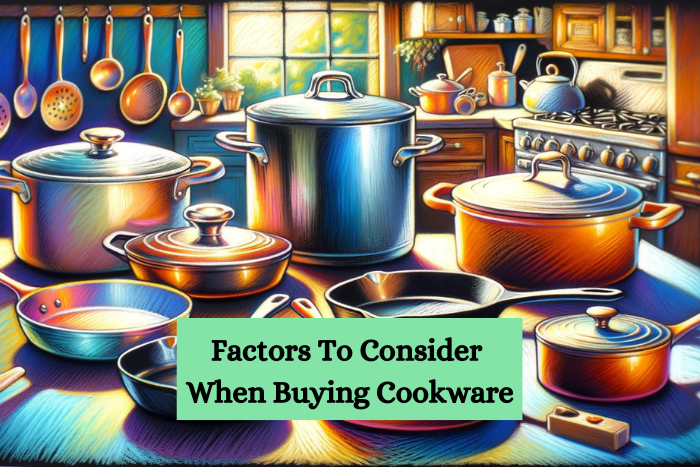When buying cookware, consider heat conductivity, price, durability, reactivity to foods, maintenance, and compatibility with your stove type. These factors affect cooking performance, longevity, and ease of use, ensuring you select the best cookware for your needs.
Heat Conductivity
Some metals are better heat conductors than others. This means the better the heat conductivity the better and more evenly your food will cook.
You want cookware that will react quickly to the temperature change when turning the heat up or down. For example, copper cookware will react more quickly to the temperature change than stainless steel cookware.
Price
The price of the cookware is most likely the determining factor in what cookware you end up buying. When buying cookware the rule of thumb is to buy the best that you can afford.
Also, think about what pieces of cookware you need. Buying piece by piece is more expensive than buying a cookware set, but then there is no reason to buy the whole set if you wind up using only a few of them.
Durability
Some cookware types maintain their good looks and last longer than others. Nothing more disappointing than buying cookware that will bend, warp, or chip easily.
Reactivity
Some metals will react with certain foods. These metals tend to react with tomatoes and other acidic foods, meaning that your food absorbs some of the metal.
You need to be aware of this when considering your cookware choices.
Maintenance
You need to consider the amount of maintenance that is required to keep your cookware looking good. Copper cookware needs polishing and cast iron needs seasoning so these types need a bit of work to keep them looking good.
What cookware is dishwasher safe and what ones require hand washing only?
Type of Stove You Will Be Cooking On
Not all types of cookware are appropriate for all stove types. Induction cooktops will need cookware with a magnetic base.
Glass stovetops need cookware with a smooth bottom and are more lightweight. If not, you must remember not to slide cookware across the top but to lift it when moving the cookware.
Many people have no understanding of the makeup of cookware or why some cookware material is better than others. So let’s take a look at some different types and the pros and cons of each one.
Types Of Cookware
Stainless Steel
The most common type of cookware and you will most likely find it in most households. It is an excellent choice for cookware with one exception: its inability to conduct heat well.
You will find that it is prone to hot spots on the cooking surface and food will not cook evenly. So you must choose stainless steel cookware with a copper or aluminum core.
Stainless steel cookware will last a lifetime.
Pros
- Fairly inexpensive
- Durable
- Scratch-resistant
- Keeps it a shiny look
- Doesn’t react with foods
- Warp resistant
Cons
- Poor conductor of heat
Cast Iron Cookware
Cast iron cookware has been around for generations. Many that use cast iron swear by it for its excellent cooking ability.
However one needs to be aware that cast iron is not easy to maintain. Cast iron needs some effort to keep it working as it should.
Cast iron is extremely durable and cookware that has been handed down from one generation to the next. Read this article for more information on cast iron.
Pros
- Fairly inexpensive
- Extremely durable
- Good heat retention
Cons
- Reacts with food unless it is seasoned
- High maintenance; requires regular seasoning
- Heavy
- Prone to rust if not cared for correctly
Aluminum Cookware
50% of aluminum is used in cookware made today due to its excellent heat conduction. Aluminum is a soft metal and can dent and scratch easily.
It can also react with certain foods. Aluminum cookware is often finished with a nonstick coating to ensure foods do not stick or burn.
Pros
- Excellent heat conduction
Cons
- Reacts with acidic foods
- Scratches and dents easily
Copper Cookware
Copper cookware is commonly used by chefs because it conducts heat extremely well, in that it heats quickly and adjusts to changes in temperature as well, allowing greater control over your cooking. This cookware is expensive and not seen often in home kitchens.
Pros
- Excellent heat conductivity
Cons
- Fairly expensive
- Reacts to acidic foods
- Needs regular polishing
My Final Thoughts
- Consider the material of the cookware, as it affects heat conductivity and cooking performance, similar to choosing between cast iron, which retains heat well, and stainless steel, known for even heat distribution.
- Think about the cookware’s maintenance requirements, with some materials like copper needing more care, akin to the way high-end knives require regular sharpening.
- Assess compatibility with cooking appliances, ensuring, for example, that induction cookware is used on induction cooktops, similar to matching microwave-safe dishes with microwave use.
- Factor in the durability of the cookware, understanding that some types, like hard-anodized aluminum, offer more resistance to wear and tear, comparable to high-quality outdoor gear that withstands harsh conditions.
- Consider the cost and investment in cookware, weighing up-front expenses against long-term value, akin to investing in a quality piece of furniture that lasts for years.
Making the final decision on what type of cookware you want, whether it is stainless steel, cast iron, aluminum, or copper comes down to a personal decision based on how much time you spend cooking, how experienced you are in the kitchen, and your budget. Remember, buy the best you can for your money.
For all-around flexibility, usability, and price, stainless steel cookware is at the top of the list. Considering the pros, it beats the other types of cookware hands down but with one drawback; it does not conduct heat very well.
So if you are worried about having evenly cooked food then heat conduction is important. The solution: clad cookware!
It is cookware that is made up of several layers of different metals. Such as stainless steel cookware with a layer of copper or aluminum.
Stainless steel with a copper base will be more expensive than an aluminum base, but it will have better heat conduction. Take time choosing your cookware, buy the best you can afford, follow the manufacturer’s recommendations on the care of your cookware and you will be satisfied with many years of use and a pleasant cooking experience.
I hope you found this article informative and helpful in your journey to buying new cookware. And as always, have a wonderful day!
FAQ: 6 Key Factors to Consider When Buying Cookware
What should I consider when choosing cookware based on heat conductivity?
- Importance of Heat Conductivity: The ability of cookware to conduct heat affects how evenly your food cooks. Materials like copper are excellent at conducting heat and react quickly to temperature changes, preventing hot spots.
- Material Choices: While copper offers superior heat conductivity, it is more expensive. Alternatives like aluminum also conduct heat well and are more budget-friendly, though they may not offer the same quick response to temperature changes as copper.
How does the price influence cookware selection?
- Budget Considerations: Price often dictates the quality and type of cookware you can buy. Investing in high-quality cookware might be more costly upfront but can offer better cooking performance and durability.
- Set vs. Individual Pieces: Consider whether buying individual pieces or a complete set suits your cooking needs and budget. Purchasing individual pieces can be more expensive initially but ensures you only buy what you need.
What are the durability concerns with different types of cookware?
- Material Durability: Stainless steel and cast iron are known for their longevity and resistance to warping or chipping. Choosing durable materials ensures that your cookware can withstand frequent use.
- Care and Maintenance: Some materials, like cast iron, require more maintenance to maintain their condition, such as regular seasoning to prevent rust and ensure non-stick properties.
How do different cookware materials react with foods?
- Reactivity with Acidic Foods: Materials like aluminum and copper can react with acidic foods, such as tomatoes, which might lead to metal leaching into the food. It’s essential to be aware of this when preparing dishes with acidic ingredients.
- Food Safety and Taste: Using non-reactive materials like stainless steel ensures that the cookware does not affect the flavor or safety of your food.
What maintenance is required for different cookware materials?
- Ease of Maintenance: Stainless steel is relatively low-maintenance and often dishwasher-safe, making it a convenient option for everyday use.
- Special Care Requirements: Copper requires regular polishing to maintain its appearance, and cast iron must be seasoned to protect its surface and enhance its non-stick properties.
How does the type of stove affect cookware choices?
- Compatibility with Stove Types: Not all cookware works with all stove types. For instance, induction cooktops require cookware with a magnetic base, while glass stovetops work best with cookware that has a smooth, flat bottom to prevent scratches.
- Adapting Cookware to Stove Type: Ensure that the cookware you choose is suitable for the type of stove you have to maximize efficiency and prevent damage to both the stove and the cookware

I’m Diane, a culinary enthusiast who loves to share my cooking adventures and knowledge with you.
This blog is my cozy corner on the internet where I unravel the secrets behind making everyday cooking simple, enjoyable, and downright delicious.
Whether it’s unlocking the flavor potential in chicken or figuring out why your mashed potato cakes won’t hold together, I’m here to guide you through.
Join me as we explore various dishes, solve common kitchen dilemmas, and discover new recipes that will make you fall in love with cooking all over again.
Cooking is an adventure that’s best shared, so let’s get started!

